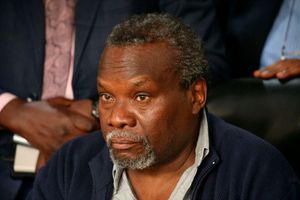
Nakuru-based journalists protest along Kenyatta Avenue in Nakuru Town against the shooting of one of their own Catherine Kariuki (K24 Reporter) during anti-government protest.
While the United States is pushing forward with its strategic partnerships with Kenya, it remains concerned about the Kenya government’s respect for human rights. The two countries are looking to conclude, in particular, the Strategic Trade and Investment Partnership (STIP) by year-end, but US Trade Representative Katherine Tai only this week sounded the alarm bells over Nairobi’s failure to protect the freedom of expression, respect human and gay rights.

US Trade Representative Katherine Tai.
And this was before K24 journalist Wanjeri Kariuki was shot by police in the street in Nakuru on Tuesday as she covered the anti-government protests and veteran editor Macharia Gaitho was abducted from Karen police station by undercover officers though he quickly released in the face of gathering local and international outrage.

Catherine Wanjeri Kariuki, K24 journalist.
Police have fired teargas at CNN Correspondent Larry Madowo, among other high profile journalists, in recent times. This is probably the worst time to be a journalist in Kenya in more than 30 years.
In the early 1980s and early 1990s, journalists were routinely picked up, brutalised by then Special Branch and at times detained without trial. Publisher, lawyer and human rights activist Gitobu Imanyara was arrested on March 1, 1991 detained without trial because of advocating for democracy in the Nairobi Law Monthly. Under tremendous pressure from the international community, particularly the US, then represented in Kenya by its bold ambassador Smith Hempstone, President Daniel arap Moi stopped the barbaric practice of torturing and sending journalists to the dungeons, but brutality did not end entirely end. In the case of the Nairobi Law Monthly, the government would send goons to disable any printing press on which it was printed. After the end of single party rule 1992, press freedom did grow, albeit slowly, both in law and practice culminating in the 2010 Constitution which, in Chapter 34, explicitly protects press freedom.
Successful media
By 2012, Kenya had one of the freest and most commercially successful media on the continent. But in 2013, a government was sworn in that ideologically believed that a free press and a vibrant civil society were bad for the country and set out, as a core agenda, to dismantle them. For the press, the take down came in four forms: An insidious conspiracy of commercial sabotage, laws which limited press freedom in the guise of serving some other seemingly high-minded aim, threats and shutdowns and arrests and physical abuse.

CNN correspondent Larry Madowo.
On December 5, 2013, Parliament passed the Kenya Information and Communication Amendment Act creating a government-controlled tribunal to take over some regulatory issues from the Media Council of Kenya and impose harsh punishment for transgressions. The Constitution is quite clear that regulatory authority must be exercised by an independent, not government-controlled, entity.
In July 2015, through an Executive Order, the President, through the Head of Public Service, directed all its advertisements to pass through its media buying arm, the Government Advertising Agency (GAA). The government claimed that GAA was a response to the absence of policy guidelines for government advertising. Ministries, departments, and other government entities were ordered to send their advertising needs to GAA which would determine on which media they would be placed and process payment through the government financial management system.
In practice, it was nothing of the sort. It became an avenue for corruption and the most outrageous gravy-train where money was paid to websites with little or no traffic and publications that had limited reach. It also gave the minister for ICT the illegal power to coerce the media to provide positive coverage in exchange for advertising. Often, if the minister did not like a headline or a story in the press, advertising would be withdrawn without any process. In January 2024, the Ruto administration directed all government advertising to be published only by The Star newspaper and KBC, claiming that the two had won a tender, denying all other media revenue.
The two companies do not have the widest reach, nor do they offer the best value for the taxpayer’s money. The 2015 Kenyatta Executive Order and its most recent Ruto escalation remain the most egregious violations of Chapter 34 and it is mystery why it has never been successfully challenged in the courts. Its existence has, finally, given the government the tool to slowly starve the media of revenue and either shrink them to small, controllable size, or kill them off altogether.
Legitimate story
On January 30, 2018, the Communications Authority of Kenya (CA) took the unprecedented step of switching off the signals of four privately owned national TV stations after they aired Opposition Leader Raila Odinga’s parallel ‘Swearing in Ceremony’ at Uhuru Park. Mr Odinga contested the results of the election and subsequently swore himself in, a big and legitimate story that the government had wanted given a blackout. NTV, Citizen TV and KTN were knocked off air, plunging the country into an almost total TV blackout.
Harassment and physical attacks on journalists are an everyday reality in Kenya, but the brutal crackdown of the last month is unprecedented. It is one of the rare occasions in recent times when authorities deliberately, openly and blatantly targeted journalists in the course of their duties, reporting the news to the public.
Kenyan society has grown in complexity and sophistication over the last 60 years. A country that is open to immigration, it is home to many nationalities which add colour and flavour. The vibrant media are a cog in the engine of innovation, bringing new ideas and challenging barriers to change and development.
As a matter of policy, media campaign for minority rights, including sexual minorities, for accountability and transparency in the management of public affairs. Media are instruments for inter-cultural understanding and relationships, helping to build and sustain diverse communities.
In a recent TV interview, President Ruto lamented the poor communication which had undermined public buy-in of his policies, contributing to the protests now gripping the country. The irony was lost on him that the media, which the governments he served in since 2013 fought so assiduously, are the best tool for creating a rapport between governments and the people by providing platforms for policy information and debate.
The bitter harvest of backward media policies hasn’t even been brought in from the field.







